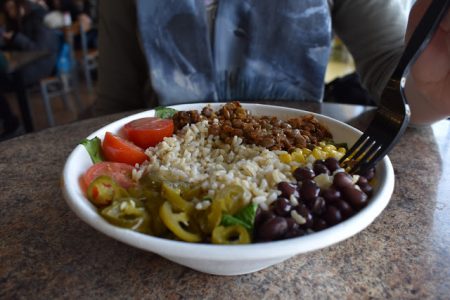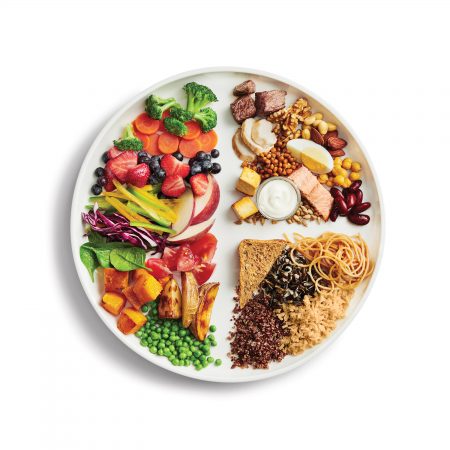Welcoming Canada's New Food Guide
Welcoming Canada’s New Food Guide
We’re excited that the newest edition to Canada’s Food Guide has been released! A simplistic approach was taken this year – the first time we haven’t seen ‘food groups’ since 1942. Canada’s Food Guide is now centered on not just what to eat, but how to eat – digging more into habits and behaviours around food. The food guide is meant to serve as a tool to be used by all Canadians for everyday life and has included more culturally diverse and familiar foods suitable to our populations in Canada. The food guide resembles the Healthy Plate Model – a well-known resource used by Dietitians today. The tool is meant to be interactive and web-based, and will continuously be updated with the most current evidenced based research.
The key messages of the new Canada’s Food Guide include:
- Make water your drink of choice
- Enjoy your food
- Cook more often
- Eat meals with others
- Use food labels
- Limit foods high in sodium, sugar and saturated fat
- Be aware of food marketing
- Be mindful of eating habits
Some may be surprised to see yogurt, but not milk or cheese as well as a lack of direction around serving sizes, while others feel there is not much a difference between the new messaging from Health Canada. All in all, it is nothing new to see guidance on consuming less sugary beverages and more whole grains. Stay tuned for part 2 coming later this year and be sure to check out the extensive set of resources and recipes at www.healthcanada.ca/foodguide.1
Top ways to follow the food guide on campus
Eat plant-forward! The food guide recommends choosing plant-based proteins more often. Plant-based proteins include beans, legumes, nuts, seeds, and tofu. Many of these non-animal sources of protein are high in fiber and low in saturated fat. 2 Check out the following restaurants on campus for plant-based protein:
- The Greens in the Food Court and Loeb Café offers up plant-based protein with their delicious Vegan Falafel Wraps and Vegan Falafel Salads.
- The Basil Box offers authentic tastes of Thai and Vietnamese cuisine. Each box is custom built and includes a base, veggies, protein, a sauce, and toppings. Choose the coconut curry tofu as your protein for a delicious plant-based meal! The Basil Box is located in the Food Court.
- Visit The Market in the Food Court! We’re serving up a plant-powered taco salad packed with spiced lentils and vegetables. It offers up a whopping 14 grams of plant protein!

Balance your plate! The new good guide recommends filling half of your plate with vegetables and fruit, one quarter of your plate with whole grains, and one quarter of your plate with protein foods. The Salad Station at the caf is your perfect one-stop-shop for creating a balanced plate that includes all these elements!

Read food labels! You can check the nutrition facts table on all of our Express grab-and-go items across retail locations including Food Court, Tunnel Junction, Loeb Café and Bent Coin. The information in a nutrition facts table is based on the serving size. Serving size can be found at the top of the nutrition facts table. You can use a nutrition facts table to compare the serving size to the amount of food you actually eat. For example, the serving size of bread in a nutrition facts table could be 1 slice. But if you eat 2 slices, you need to double the amount of calories and nutrients
A nutrition facts table can also be used to:
- learn about a food’s nutritional value (calories and nutrients)
- see if a food contains a little (5% DV or less) or a lot (15% DV or more) of a nutrient
- compare 2 products to make informed food choices
In general, use the Nutrition Facts Table to find options on campus that are higher in fiber, protein, vitamin A, vitamin C, calcium and iron. Choose options that are lower in fat, sodium and sugar. 3
Enjoy your meals with friends and classmates while you are on campus. The new food guide reminds us that enjoying healthy foods with others is a great way to connect and add enjoyment to your life. Part of enjoying your food is also enjoying the atmosphere around it. The setting around you can contribute to making meal times more satisfying. Looking for a meal with a view to enjoy with friends? We love visiting Bent Coin to grab a sandwich, soup, hot entrée or even just a cup of coffee and tea, and enjoying the view of the river that Bent Coin provides.
References
- Welcoming Canada’s New Food Guide (2019) http://www.liveitgood.ca/discover-item.html?title=123
- Introduction to Protein and High Protein Foods (2019) http://www.unlockfood.ca/en/Articles/Protein/Introduction-To-Protein-And-High-Protein-Foods.aspx
- Nutrition Facts Tables (2019) https://www.canada.ca/en/health-canada/services/understanding-food-labels/nutrition-facts-tables.html